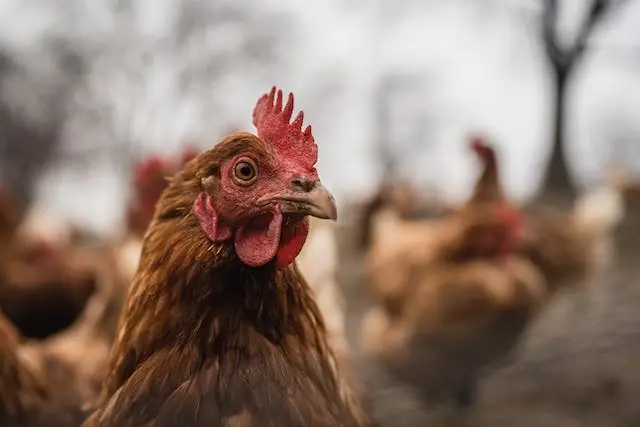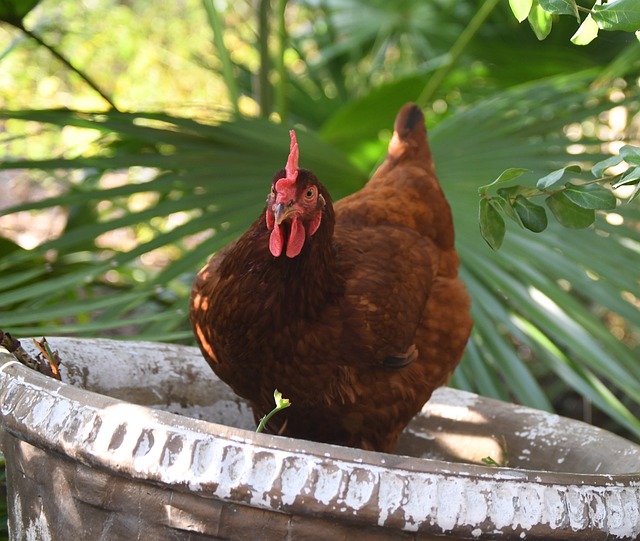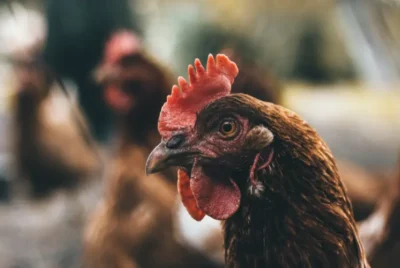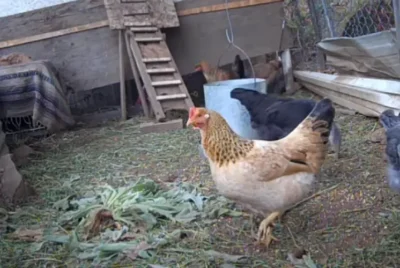Raising Rhode Island Red: Tips for Optimizing Your Flock’s Health
Rhode Island Reds are a popular breed of chicken known for their exceptional egg-laying abilities and vibrant red plumage. These birds are hardy and adaptable, making them ideal for both beginner and experienced chicken keepers. Before diving into the details of raising this chicken breed, it’s important to familiarize yourself with their unique characteristics.
Characteristics of Rhode Island Reds
Rhode Island Reds are medium-sized chickens with well-rounded bodies and single combs. They have a distinctive mahogany red color, which becomes deeper and richer as they mature. These birds possess a gentle temperament, making them great additions to backyard flocks.
Additionally, this chicken breed is known for their high-level egg production, consistently laying large brown eggs throughout the year.
Regarding physical attributes, these chickens have strong legs and feet, allowing them to forage and explore their surroundings with ease. Their feathers are dense and glossy, providing excellent protection against the elements. These chickens also have a keen sense of sight and hearing, which helps them detect potential predators and stay alert.
Another notable characteristic is their ability to withstand various climates. Whether it’s hot and humid or cold and snowy, these chickens adapt well and continue to thrive. Their hardiness makes them a popular choice for chicken keepers in different regions.
Why Choose Rhode Island Reds for Your Flock?

There are many reasons to consider adding Rhode Island Reds to your flock. Besides their beautiful appearance and friendly nature, these chickens are exceptionally reliable for egg-laying. They are known for their consistent egg production, even during colder months or when other breeds may decrease their output.
In addition to their egg-laying abilities, these chickens are generally healthy and easy to care for. They have a strong immune system, making them less susceptible to common chicken diseases. This means less worry and fewer visits to the veterinarian.
Furthermore, they enjoy exploring their surroundings and finding insects, worms, and other tasty treats. This natural behavior not only keeps them entertained but also helps reduce feed costs, as they can supplement their diet with what they find.
Lastly, Rhode Island Reds are great for families with children. Their gentle temperament and docile nature make them easy to handle and interact with. Children can learn valuable lessons about responsibility and animal care by raising and caring for these chickens.
Setting Up Your Coop for Rhode Island Reds

If you’re planning to raise Rhode Island Reds, it’s crucial to provide them with a comfortable and functional coop. Taking the time to set up your coop properly will ensure the well-being and productivity of your flock.
Space Requirements for Healthy Chickens
Rhode Island Reds require ample space to thrive. Aim for a minimum of 4 square feet per bird inside the coop, and extend that to 10 square feet per bird in the outdoor run. Enough space allows the chickens to move freely, exercise, and minimize stress.
When considering the space requirements for your Rhode Island Red chickens, it’s essential to consider their natural behaviors. These chickens are known for their active nature and love for scratching and foraging.
By providing them with enough space, you are allowing them to engage in these natural behaviors, which not only keeps them physically fit but also mentally stimulated.
Furthermore, having sufficient space also helps prevent the spread of diseases among the flock. Overcrowding can lead to stress, which weakens the chickens’ immune systems and makes them more susceptible to illnesses.
Essential Coop Features for Rhode Island Reds
The coop should be well-ventilated to prevent moisture buildup and enhance air circulation. Install windows and vents that can be adjusted according to the season. Proper ventilation is crucial in maintaining a comfortable and healthy environment for your Rhode Island Red chickens.
Another important feature to consider is the security of the coop. To ensure the safety of your flock, use sturdy materials and reinforce the doors and windows. Consider adding a predator-proof wire mesh around the coop to prevent any unwanted visitors from getting in.
Regarding nesting boxes, Rhode Island Red hens prefer privacy and comfort. Provide them with well-designed nesting boxes that are easily accessible and filled with clean bedding. This will encourage them to lay eggs in a safe and comfortable environment.
Don’t forget also to include roosting bars in your coop. Rhode Island Reds, like most chickens, prefer to sleep on elevated perches. By providing them with roosting bars, you are giving them a sense of security and allowing them to rest comfortably during the night.
Nutrition Needs of Rhode Island Reds
Feeding your Rhode Island Reds a balanced diet is essential for their health and egg production. Providing them with the right nutrients will result in stronger immune systems, vibrant feathering, and consistent egg-laying.
Rhode Island Red chickens, known for their hardiness and productivity, have specific nutritional requirements that must be met to ensure their optimal health. These requirements include a balanced combination of proteins, carbohydrates, fats, vitamins, and minerals.
Feeding Guidelines for Optimal Health
Base your Rhode Island Reds’ diet on high-quality commercial chicken feed. Look for feeds specifically formulated for laying hens, which contain essential nutrients such as calcium, protein, and vitamins. These feeds are designed to support the high demands of egg production and provide the building blocks for strong eggshells and healthy chicks.
In addition to commercial feed, supplement your flock’s diet with fresh fruits, vegetables, and kitchen scraps. Rhode Island Red chickens enjoy a variety of treats, including leafy greens, carrots, apples, and melons. These treats not only provide additional nutrients but also offer mental stimulation and enrichment. However, it is important to avoid feeding them toxic or harmful foods such as chocolate, avocado, or onions, as these can harm their health.
Furthermore, ensuring that your chickens have access to clean, fresh water. Water is essential for digestion, nutrient absorption, and overall hydration. Make sure to clean and refill their water containers regularly to prevent the growth of harmful bacteria and algae.
Supplements and Treats for Rhode Island Reds
Incorporating occasional treats into your flock’s diet can be beneficial and provide mental stimulation. Treats like mealworms, corn, or small amounts of whole grains can be given as rewards or for enrichment purposes. These treats not only add variety to their diet but also help satisfy their natural foraging instincts.
However, it is important to remember that moderation is key when offering treats to your chickens. While treats can be enjoyable for them, excessive consumption can lead to imbalances in their diet and potentially affect their overall health. It is recommended to limit treats to no more than 10% of their daily food intake.
Additionally, if you notice any changes in your Rhode Island Reds’ behavior, egg production, or overall health, I advise consulting a poultry veterinarian. They can provide guidance specific to your flock’s needs and help address any nutritional deficiencies or imbalances affecting their well-being.
Health Concerns Specific to Rhode Island Reds

Although Rhode Island Reds are generally hardy, they can still be susceptible to certain health issues. By implementing preventative measures and monitoring their well-being regularly, you can ensure your flock stays in peak condition.
Common Diseases and How to Prevent Them
Rhode Island Reds can be prone to common poultry diseases such as Marek’s disease and coccidiosis. Vaccinating your flock against these diseases and practicing good biosecurity measures, like regular coop cleaning and quarantine protocols, can help to prevent outbreaks.
Marek’s disease is a highly contagious viral illness that affects chickens, causing tumors, paralysis, and eventually death. It is spread through feather dander and can survive in the environment for months. Vaccination is the most effective way to protect your Rhode Island Reds from this devastating disease.
Additionally, practicing good biosecurity measures, such as limiting visitors to your flock and disinfecting equipment, can help prevent the introduction and spread of the virus.
Coccidiosis, on the other hand, is a parasitic disease caused by protozoa. It affects the intestinal tract of chickens, leading to diarrhea, weight loss, and decreased egg production. To prevent coccidiosis, it is important to maintain a clean and dry environment for your Rhode Island Reds.
Regularly clean their coop, provide fresh bedding, and ensure proper ventilation. Additionally, you can use coccidiostats, medications that help control the parasite population, as a preventative measure.
Read also: Best Vaccinations for Chickens To Prevent Common Diseases
Regular Health Checks for Your Flock
Routine health checks are crucial for identifying potential issues early. Regularly inspect your birds, checking for signs of illness, abnormal behavior, or any injuries. Promptly address any concerns by consulting a veterinarian or seeking advice from experienced chicken keepers.
During your health checks, pay close attention to the physical appearance of your Rhode Island Reds. Look for any abnormalities such as ruffled feathers, discharge from the eyes or nostrils, or changes in appetite. These could be signs of an underlying health problem that needs to be addressed.
Additionally, observe their behavior and interactions within the flock. Any sudden aggression, lethargy, or isolation could indicate a health issue or social dynamic that requires attention.
It is also important to regularly inspect your chickens for injuries. Chickens can be prone to pecking each other, leading to wounds and infections. Check their feathers, skin, and feet for any signs of damage or inflammation. If you notice any injuries, clean them thoroughly and apply appropriate wound care products. In severe cases, it may be necessary to separate the injured bird from the rest of the flock to prevent further harm.
Breeding Rhode Island Reds for a Robust Flock

For those interested in expanding their flock or breeding Rhode Island Reds, it’s important to carefully select breeding pairs and provide proper care during the incubation process.
Rhode Island Reds are a popular breed of chicken known for their excellent egg-laying abilities, strong immune systems, and good temperament. When selecting breeding pairs, it is crucial to choose birds with these desirable traits to ensure the production of a robust flock.
However, it’s not just about selecting birds based on their traits alone; assessing characteristics like body conformation, feather color, and overall health is equally important.
One crucial aspect to consider when breeding this breed is the avoidance of breeding birds that are closely related. Inbreeding can lead to genetic issues and a decline in the overall health and vigor of the flock.
To prevent this, it is essential to diversify the gene pool by introducing unrelated birds into the breeding program.
By doing so, you can maintain the breed’s genetic diversity and prevent the accumulation of harmful genetic mutations.
Incubation and Chick Care
If you decide to incubate Rhode Island Red eggs, it is vital to ensure that the temperature and humidity levels in the incubator are appropriate. Maintaining the ideal conditions for incubation is crucial for the successful development of the embryos. It is recommended to follow the manufacturer’s guidelines for incubation duration and monitor the eggs closely throughout the process.
Once the eggs hatch, the care for the chicks becomes paramount. Providing a warm and secure brooder area is essential for their well-being. The brooder area should be free from drafts and predators, ensuring the safety of the vulnerable chicks.
Additionally, it is crucial to provide clean water and a balanced chick starter feed to meet their nutritional needs. The feed should contain the nutrients to support their growth and development, ensuring a strong foundation for a healthy life.
As the chicks grow, it is important to continue monitoring their health and providing appropriate care. Regularly check for any signs of illness or abnormalities, as early detection can prevent the spread of diseases and ensure prompt treatment.
Additionally, providing a stimulating environment with appropriate enrichment activities can help promote their physical and mental well-being.
The Importance of Regular Exercise for Rhode Island Reds
Exercise is an important aspect of maintaining the overall health and well-being of Rhode Island Reds. Providing ample opportunities to stretch their wings and engage in natural behaviors contributes to their physical and mental fitness.
Creating a Safe and Stimulating Run
Allow your Rhode Island Reds access to a spacious outdoor run where they can scratch, peck, and forage. Provide plenty of shade, dust bathing areas, and perches for them to rest and roost. Ensuring the run is predator-proof will give your flock the freedom to move around without risks.
The Impact of Exercise on Health and Egg Production
Regular exercise positively influences the overall health of Rhode Island Reds and can contribute to better egg production. Exercise helps to stimulate their metabolism, maintain muscle tone, and reduce the likelihood of obesity and related health issues. Chickens that enjoy regular exercise are generally happier and more productive layers.
Winter Care for Rhode Island Reds
Preparing Your Coop for Cold Weather
Insulate the coop to retain warmth and prevent drafts. Cover windows with plastic sheeting or use insulation panels. Add extra bedding, such as straw or wood shavings, to provide insulation and help your birds stay cozy. Install a reliable heat source, such as a heat lamp, if necessary.
Special Considerations for Rhode Island Reds in Winter
During winter, Rhode Island Reds may require additional nutrition to maintain their body temperature. Ensure they have access to a well-balanced diet and provide warm, fresh water daily. A dust-free, dry environment prevents frostbite and other cold-related issues.
By understanding the unique characteristics of these breeds, setting up an appropriate coop, providing a balanced diet, addressing health concerns, and offering regular exercise and care, you will be well on your way to optimizing the health and well-being of your flock. Dedicate time and attention to their needs, and you will enjoy the rewards of vibrant, productive chickens for years.




